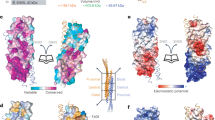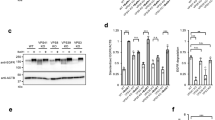Abstract
Vesicles coated with coat protein complex II (COPII) selectively transport molecules (cargo) and vesicle fusion proteins from the endoplasmic reticulum (ER) to the Golgi complex1,2,3. We have investigated the role of coat proteins in cargo selection and recruitment. We isolated integral membrane and soluble cargo proteins destined for transport from the ER in complexes formed in the presence of Sar1 and Sec23/24, a subset of the COPII components, and GTP or GMP-PNP. Vesicle fusion proteins of the vSNARE family and Emp24, a member of a putative cargo carrier family4, were also found in COPII complexes. The inclusion of amino-acid permease molecules into the complex depended on the presence of Shr3, a protein required for the permease to leave the ER3,5. Resident ER proteins Sec61, BiP (Kar2) and Shr3 were not included in the complexes, indicating that the COPII components bound specifically to vesicle cargo. COPII–cargo complexes and putative cargo adaptor–cargo complexes were also isolated from COPII vesicles. Our results indicate that cargo packaging signals and soluble cargo adaptors are recognized by a recruitment complex comprising Sar1–GTP and Sec23/24.
This is a preview of subscription content, access via your institution
Access options
Subscribe to this journal
Receive 51 print issues and online access
$199.00 per year
only $3.90 per issue
Buy this article
- Purchase on Springer Link
- Instant access to full article PDF
Prices may be subject to local taxes which are calculated during checkout







Similar content being viewed by others
References
Salama, N. R., Yeung, T. & Schekman, R. W. The Sec13p complex and reconstitution of vesicle budding from the ER with purified cytosolic proteins. EMBO J. 12, 4073–4082 (1993).
Barlow, C. et al. COPII: A membrane coat formed by Sec proteins that drive vesicle budding from the endoplasmic reticulum. Cell 77, 895–907 (1994).
Kuehn, M. J., Schekman, R. & Ljungdahl, P. O. Amino acid permeases require COPII components and the ER resident membrane protein Shr3p for packaging into transport vesicles in vitro. J. Cell Biol. 135, 585–595 (1996).
Schimmöller, F. et al. The absence of Emp24p, a component of ER-derived COPII-coated vesicles, causes a defect in transport of selected proteins to the Golgi. EMBO J. 14, 1329–1339 (1995).
Ljungdahl, P. O., Gimeno, C. J., Styles, C. A. & Fink, G. R. SHR3: a novel component of the secretory pathway specifically required for localization of amino acid permeases in yeast. Cell 71, 463–478 (1992).
Barlowe, C. & Schekman, R. SEC12 encodes a guanine-nucleotide-exchange factor essential for transport vesicle budding from the ER. Nature 365, 347–349 (1993).
Yoshihisa, T., Barlowe, C. & Schekman, R. Requirement for a GTPase-activating protein in vesicle budding from the endoplasmic reticulum. Science 259, 1466–1468 (1993).
Yeung, T., Barlowe, C. & Schekman, R. Uncoupled packaging of targeting and cargo molecules during transport vesicle budding from the endoplasmic reticulum. J. Biol. Chem. 270, 30567–30570 (1995).
Kuehn, M. J. & Schekman, R. COPII and secretory cargo capture into transport vesicles. Curr. Opin. Cell Biol. 9, 477–483 (1997).
Stamnes, J. A. et al. An integral membrane component of coatomer-coated transport vesicles defines a family of proteins involved in budding. Proc. Natl Acad. Sci. USA 92, 8011–8015 (1995).
Fiedler, K., Veit, M., Stamnes, M. A. & Rothman, J. E. Bimodal interaction of coatomer with the p24 family of putative cargo receptors. Science 273, 1396–1399 (1996).
Barlow, C., d'Enfert, C. & Schekman, R. Purification and characterization of Sar1p, a small GTP binding protein required for transport vesicle formation from the endoplasmic reticulum. J. Biol. Chem. 268, 873–879 (1993).
Fiedler, K. & Simons, K. The role of N-glycans in the secretory pathway. Cell 81, 309–312 (1995).
Sikorski, R. S. & Heiter, P. Asystem of shuttle vectors and yeast host strains designed for efficient manipulation of DNA in Saccharomyces cerevisiae. Genetics 122, 19–27 (1989).
Hicke, L., Yoshihisa, T. & Schekman, R. Sec23p and a novel 105 kD protein function as a multimeric complex to promote vesicle budding from the ER. Mol. Biol. Cell 3, 667–676 (1992).
Stirling, C. J., Rothblatt, J., Hosobuchi, M., Deshaies, R. & Schekman, R. Protein translocation mutants defective in the insertion of integral membrane proteins into the endoplasmic reticulum. Mol. Biol. Cell 3, 129–142 (1992).
Brodsky, J. L. & Schekman, R. ASec63p-BIP complex from yeast is required for protein translocation in a reconstituted proteoliposome. J. Cell Biol. 123, 1355–1363 (1993).
Bednarek, S. Y. et al. COPI- and COPII-coated vesicles bud directly from the endoplasmic reticulum in yeast. Cell 83, 1183–1196 (1995).
Evan, G. I., Lewis, G. K., Ramsay, G. & Bishop, J. M. Isolation of monoclonal antibodies specific for human c-myc proto-oncogene product. Mol. Cell. Biol. 5, 3610–3616 (1985).
Acknowledgements
We thank S. Bednarek, M. Bowser and L. Liang for performing experiments; P.Ljungdahl, R. Lesch, M. Pilon and A. Corsi for materials; and J. Campbell, T. Doering and other lab members for suggestions. This work was supported by the Howard Hughes Medical Institute (R.S. and M.K.) and the Cancer Research Fund fo the Damon Runyon-Walter Winchell Foundation (M.K.). J.H. was supported by a fellowship from the Deutsche Forschungsgemeinschaft.
Author information
Authors and Affiliations
Corresponding author
Rights and permissions
About this article
Cite this article
Kuehn, M., Herrmann, J. & Schekman, R. COPII–cargo interactions direct protein sorting into ER-derived transport vesicles. Nature 391, 187–190 (1998). https://doi.org/10.1038/34438
Received:
Accepted:
Issue Date:
DOI: https://doi.org/10.1038/34438
This article is cited by
-
Kinetic control of shape deformations and membrane phase separation inside giant vesicles
Nature Chemistry (2024)
-
Unconventional protein secretion (UPS): role in important diseases
Molecular Biomedicine (2023)
-
Nutrient deprivation alters the rate of COPII subunit recruitment at ER subdomains to tune secretory protein transport
Nature Communications (2023)
-
COPII mitigates ER stress by promoting formation of ER whorls
Cell Research (2021)
-
CLN8 is an endoplasmic reticulum cargo receptor that regulates lysosome biogenesis
Nature Cell Biology (2018)
Comments
By submitting a comment you agree to abide by our Terms and Community Guidelines. If you find something abusive or that does not comply with our terms or guidelines please flag it as inappropriate.



